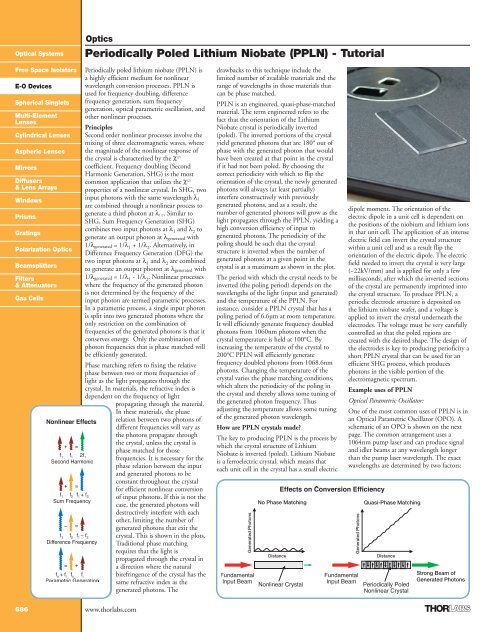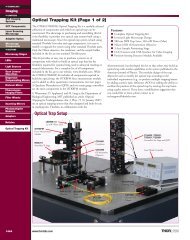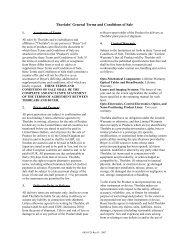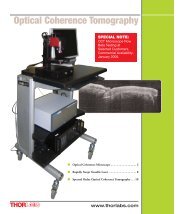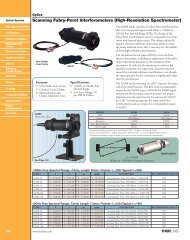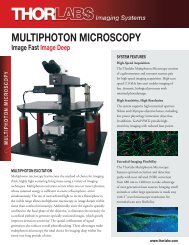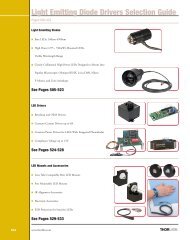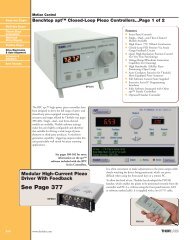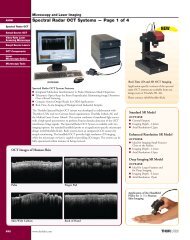Periodically Poled Lithium Niobate (PPLN) - Tutorial - Thorlabs
Periodically Poled Lithium Niobate (PPLN) - Tutorial - Thorlabs
Periodically Poled Lithium Niobate (PPLN) - Tutorial - Thorlabs
- No tags were found...
Create successful ePaper yourself
Turn your PDF publications into a flip-book with our unique Google optimized e-Paper software.
OpticsOptical Systemsenergy conservation and phase matching.Energy conservation dictates that the sum ofthe energy of a signal photon and an idlerphoton must equal the energy of a pumpphoton. Therefore an infinite number ofgenerated photon combinations are possible.However, the combination that will beefficiently produced is the one for which theperiodicity of the poling in the lithiumniobate creates a quasi-phase matchedcondition. The combination of wavelengthsthat is quasi-phase matched, and hencereferred to as the operation wavelength, isaltered by changing the <strong>PPLN</strong> temperature orby using <strong>PPLN</strong> with a different poling period.Nd:YAG pumped OPOs based on <strong>PPLN</strong> canefficiently produce tunable light atwavelengths between 1.3 and 5µm and caneven produce light at longer wavelengths butwith lower efficiency. The <strong>PPLN</strong> OPO canproduce output powers of several watts andcan be pumped with pulsed or CW pumplasers.Second Harmonic Generation:<strong>PPLN</strong> is one of the most efficient crystals forfrequency doubling. It has been used tofrequency double pulsed 1064nm beams withup to 80% conversion efficiency in a singlepass, thus eliminating the need for difficultlaser designs with intra-cavity doublingcrystals or matched external cavities, whichare needed with conventional doublingcrystals. The power handling is excellent forinfrared pump and output wavelengths (e.g.SHG of 1550nm → 775nm); however, whenusing <strong>PPLN</strong> to frequency double into thevisible, the power handling ability of thecrystal is more limited. It has beendemonstrated that <strong>PPLN</strong> can handle up to600mW at 532nm when frequency doubling1064nm. The exact power handling limit andconversion efficiency depend on theproperties of the laser beam used (e.g. pulselength, repetition rate, beam quality, and linewidth.)How to use <strong>PPLN</strong>Focusing and the Optical Arrangement:Since <strong>PPLN</strong> is a nonlinear material, thehighest conversion efficiency from inputphotons to generated photons will occurwhen the intensity of photons in the crystal isthe greatest. This is normally accomplished bycoupling focused light into the center of the<strong>PPLN</strong> crystal through the end face of thecrystal at normal incidence. For a particularlaser beam and crystal, there is an optimumspot size to achieve optimum conversionefficiency. If the spot size is too small, theintensity at the waist is high, but the Rayleighrange is much shorter than the crystal.Therefore, the size of the beam at the inputface of the crystal is large, resulting in a loweraverage intensity over the whole crystallength, which reduces the conversionefficiency. A good rule of thumb is that for aCW laser beam with a Gaussian beam profile,the spot size should be chosen such that theRayleigh range is half the length of the crystal.The spot size can then be reduced in smallincrements until the maximum efficiency isobtained. The <strong>PPLN</strong> material has a highindex of refraction that results in a 14%Fresnel loss per uncoated surface. To increasethe transmission through the crystals, thecrystal input and output facets are AR coated,thus reducing the reflections at each surface toless than 1%.Polarization:The polarization of the input light must bealigned with the dipole moment of the crystalin order to utilize the nonlinear properties oflithium niobate. This is accomplished byaligning the polarization axis of the light withthe thickness of the crystal. Light polarizedorthogonal to the thickness of the crystal willbe transmitted through the crystal unaltered.Temperature and Period:The poling period (PP) in the crystal isdetermined by the wavelength of light beingused. The quasi-phase-matched wavelengthcan be tuned slightly by varying thetemperature of the crystal, which changes thepoling period. The <strong>Thorlabs</strong>/Stratophase<strong>PPLN</strong> crystals all have multiple PP sections ineach crystal, each with a different polingperiod, which allows different wavelengths tobe used at a given crystal temperature. Theoptimum temperature can be determined byadjusting the temperature while monitoringthe output power at the generatedwavelength. <strong>PPLN</strong> is usually used attemperatures between 100°C and 200°C.The <strong>Thorlabs</strong>/Stratophase <strong>PPLN</strong> oven is easyto incorporate into an optical setup and canstably maintain the elevated temperature ofthe crystal. Temperatures in the 100°C-200°Crange are used in order to minimize thephotorefractive effect that can damage thecrystal and causes the output beam to bedistorted. Since the photorefractive effect ismore severe in <strong>PPLN</strong> when higher energyphotons in the visible part of the spectrum arepresent in the crystal, it is especiallyimportant to use the crystal only in therecommended temperature range. Whenusing a <strong>PPLN</strong> crystal as an OPO that ispumped with and generates light in theinfrared region of the spectrum, it may bepossible to use temperatures lower than100°C if necessary without damaging thecrystal.Free Space IsolatorsE-O DevicesSpherical SingletsMulti-ElementLensesCylindrical LensesAspheric LensesMirrorsDiffusers& Lens ArraysWindowsPrismsGratingsPolarization OpticsBeamsplittersFilters& AttenuatorsGas CellsOPO Input MirrorHigh Transmission at Pump λR = 100% at Signal λOPO Output MirrorHigh Transmission at Idler λR = 70% at Signal λ<strong>Periodically</strong><strong>Poled</strong> Regionswww.thorlabs.com687
Example ApplicationsFrequency doubling and tripling an Erbium fiber laserOpticsOptical SystemsFree Space IsolatorsE-O DevicesFiber laser, 1536nm10ns pulses1536nm<strong>PPLN</strong>CrystalResidual1536nm768nm<strong>PPLN</strong>Crystal384nmSpherical SingletsMulti-ElementLensesCylindrical LensesAspheric LensesMirrors■ 83% Conversion Efficiency (1536nm → 768nm)■ 34% Conversion Efficiency (768nm → 384nm)■ Excellent Beam QualityReference – “Highly efficient second-harmonic and sum-frequency generation of nanosecond pulses in a cascaded erbium-doped fiber: periodically poled lithium niobate source”, D.Taverner, et al.Optics Letters Vol. 23, (3), 162-164, (1998).High Power 473nm generationDiffusers& Lens ArraysWindowsPrismsGratingsPolarization OpticsBeamsplittersFilters& Attenuators946nm diode pumpedNd:YAG, 300ns pulses946nm<strong>PPLN</strong>Crystal473nmGas Cells■■■■450mW Average Power at 473nm40% Conversion EfficiencyNo Observed Photorefractive EffectExcellent Beam QualityReference – “Generation of high-power blue light in periodically poled LiNbO3”, G.W.Ross et al. Optics Letters 23, (3) 171-173 (1998).Generation of picosecond, tunable, infrared lightMode locked 1047nmNd:YLF, 4ps pulses1047nm<strong>PPLN</strong>Crystal1.3 – 5.3µmSignal & Idler■ 4ps Pulses Tunable IR Light, 1.3 – 5.3µm■ Signal Power: >400mW■ Slope Efficiency, Signal and Idler up to 160%■ Threshold: 7.5mWReference – “Efficient, low-threshold synchronously-pumped parametric oscillation in periodically-poled lithium niobate over the 1.3µm to 5.3µm range" L.Lefort et al. Optics Communications152, (1-3), 55-58 (1998).www.thorlabs.com689


